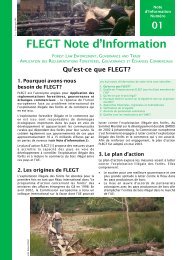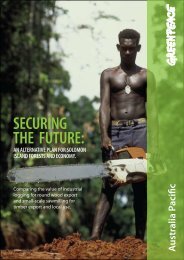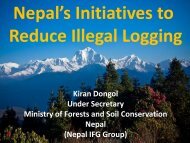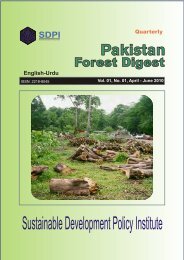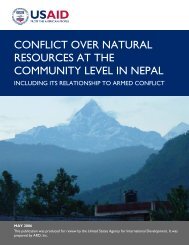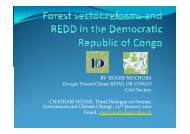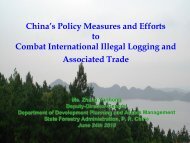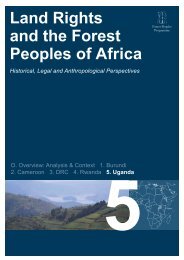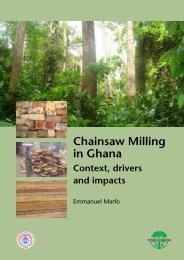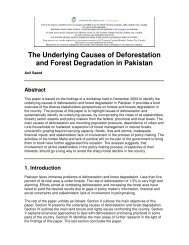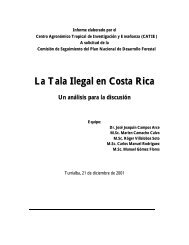Awareness Raising tool - Illegal Logging Portal
Awareness Raising tool - Illegal Logging Portal
Awareness Raising tool - Illegal Logging Portal
You also want an ePaper? Increase the reach of your titles
YUMPU automatically turns print PDFs into web optimized ePapers that Google loves.
TOOLKIT<br />
<strong>Awareness</strong> <strong>Raising</strong> <strong>tool</strong><br />
• Creating anti-corruption comic<br />
Book<br />
• Creating anti-forest corruption<br />
advertisement<br />
• Draw attention to lost forest<br />
revenue<br />
• Educate journalists<br />
• Create a forest corruption risk map<br />
DESCRIPTION<br />
Produce a series of short plays or skits that illustrate the problems of corruption. The exact format would depend on the local<br />
culture.<br />
Make an anti-corruption exhibit for a public fair or market. A small information booth could offer landowners information on<br />
both good forestry and their legal rights. It could also offer the general public information to raise awareness of corrupt practices<br />
in the forest. A more sophisticated booth at a trade fair can promote business principles, integrity pacts, and other anti-corruption<br />
<strong>tool</strong>s for the corporation.<br />
Create anti-corruption forest comic books. The books will carry the messages “Don’t pay bribes to police or foresters” and<br />
“Don’t let people steal our trees!”<br />
Creation of variety of means to advertise to a broader audience the damaging effect of corruption. The means could include<br />
roadside signs, bumper stickers, posters, radio spots, or even television.<br />
Estimate and publicize lost revenues by commissioning a study to estimate the amount of public money lost due to illegal<br />
logging and related corruption, and the rate at which losses occur. This may include loss of stumpage fees or royalties and tax<br />
revenues, and also loss of future income due to lack of forest management. Create a way to dramatize the amount, such as a<br />
clock-driven sign or web page that gives an instantaneous updated estimate, so that people can watch the money fly away.<br />
Hold educate-the-press sessions. Invite journalists to briefings on forest corruption. The briefings could be done as a workshop,<br />
or perhaps better, as a series of breakfast or lunch meetings over several weeks or months. The speakers should include activists,<br />
experts, and reform-minded officials. The briefings would be done “off-the-record” — with the journalists promising not to cover<br />
the briefing as a news event or to quote the speaker — to encourage more candid discussion.<br />
Creation of a risk map involves the process of identifying, measuring, and grading the risks of corruption in the forest sector in<br />
particular parts of the country. Preliminary analysis and review of it should be carried out in workshops with government,<br />
business, and civil society participants. A final report with maps or tables showing must include, for example, the level of<br />
pressure for corrupt activities, the local resistance or openness to corruption, and the potential for ecological damage from<br />
corrupt activities.<br />
Procurement <strong>tool</strong>s<br />
• Put together concession manual<br />
A forest concession bidder’s manual should be produced alongside the organisation of concessions workshops. These would<br />
guide enterprises large and small seeking to compete for concessions and would clarify the private parties’ rights. The materials<br />
would describe the laws that apply to the process, the agencies that implement the laws, the fees involved, and the deadlines or<br />
typical time necessary for the agency to process requests. The workshops should include agency officials.<br />
Create a country-specific website with information on advertised and active forest concessions. Such a website should include
• Create concession website information useful to potential bidders, so that more may participate, and information that will allow the public to judge whether<br />
particular concessions have been awarded fairly and whether the terms of the concession are being followed.<br />
Access to information <strong>tool</strong><br />
Hold a multi-national anti-corruption- practices-in-the-forest-sector conference. TI national chapters, public officials, business<br />
leaders, and others must assemble to discuss best practices.<br />
• Encourage forest certification<br />
• Programme to encourage forest<br />
whistleblowers<br />
Forest certification programs set standards for production of forest products and then certify whether products or producers meet<br />
those<br />
standards. The most prominent programs today focus on following environmental standards, but programs may also include<br />
social standards, such as worker safety or compliance with laws. Some programs are self policed, while others rely on<br />
independent audits.<br />
Some programs certify the forest management program, while others include chain-of-custody tracking and certify the products<br />
produced. Some programs include transparency provisions, which allow interested citizens and groups access to information on<br />
past or planned forest management activities.<br />
1) documentation and tracking of efforts to combat forest corruption, providing where possible information on each effort’s<br />
success and potential for dissemination; 2) a library of links to documents, articles, news reports, and other publications relevant<br />
to forest corruption.<br />
Create an Internet-based analytical clearinghouse for identifying best practices in the fight against forest corruption and illegal<br />
logging. This should include an informed outline of activities to:<br />
- encourage forest certification<br />
- encourage forest whistleblowers<br />
Whistleblowers will facilitate ongoing discussion among practitioners on forest corruption issues. A program to support<br />
whistleblowers and other agencies that regulate forest commerce in the forestry sector. The implementation of the whistleblower<br />
protection law could be monitored, and the government, encouraged to honoring it. The program could offer confidential<br />
counseling to potential or actual whistleblowers. In cases where the government offers no protection to whistleblowers, it may be<br />
appropriate to offer to take anonymous complaints and have a mechanism for objective and discreet screening of these<br />
complaints to identify serious concerns.<br />
Business ethic <strong>tool</strong><br />
• Conference on professional<br />
responsibility<br />
It entails an agreement between a government agency or department and all the private sector bidders for one or several public<br />
contracts. All parties agree that bidders will not offer bribes and that public officials will not demand bribes. TI National<br />
Chapters and other nationally based NGOs play a key role in monitoring and overseeing such a pact. Publicize the principles and<br />
assist businesses that wish to adopt them.<br />
Hold a national or regional conference or workshop on professional responsibility and ethics should be organized for foresters.
• Create model profession ethic codes<br />
for foresters<br />
An Integrity Pact (IP) is a <strong>tool</strong> to discourage corruption in public contracting. The IP is enforced by ensuring maximum<br />
transparency at every stage of the process, a careful monitoring of the process by independent observers such as local NGOs, and<br />
the application of severe sanctions when violations occur. Civil society organizations TI National Chapters and other nationally<br />
based NGOs play a key role in monitoring and overseeing such a pact.<br />
A forest sector IP could: a) increase accountability and transparency by enhancing publicity and access to information on logging<br />
concession awarding processes; b) create equity and efficiency in such processes; c) reduce the high costs of corruption to both<br />
governments and bidders, and counter distortion of the concession and timber market; d) provide a basis for further monitoring<br />
whether a company abides to the concession granted; e) facilitate and enhance sustainable timber harvest and sustainable forest<br />
management by strengthening environmentally responsible companies; and f) help the government to curb the evasion of<br />
concession and royalty payments that can be used for forest conservation, improving the quality of forest resources and<br />
development projects.<br />
Convene a committee of stakeholders to draft a set of model anti-corruption principles for businesses in the forest sector.<br />
Working with an organization such as the International Society of Tropical Foresters, draft a model code of professional behavior<br />
for foresters in developing countries. The model code could either focus on corruption or it could be broader, dealing with other<br />
areas of social responsibility, such as environmental stewardship.<br />
.<br />
Public institution <strong>tool</strong><br />
A “Medal of Merit” award with annual private awards to public employees, government offices, or citizens who helped reduce<br />
corruption or eliminate waste, fraud, or abuse of authority in the forest sector must be organised. A public nominating process<br />
with the creation of a panel of prominent citizens to judge the nominees and select the winners could raise the profile of the<br />
project and also give weight to the effort.<br />
• Document forest agency staffing<br />
and structure<br />
• Agency citizen workshops on<br />
corruption<br />
Create and publish a complete organogram or roster of forest agency personnel, with contact information for senior officials. The<br />
organogram would illustrate the organization of the agency, explaining the roles of the various branches. It would also reveal<br />
exactly how many people worked in each branch, and at what rank. Revise the roster regularly to keep it accurate.<br />
Offer training for law enforcement officials on technical issues related to forest corruption. For example, customs agents could be<br />
trained in recognizing species of wood to help detect mislabeled shipments. Finding a pattern of such shipments could suggest<br />
illegality and perhaps corruption in the harvest of the wood. Police could be trained in investigating accounts to detect signs of<br />
fraud or abuse of power. Prosecutors could be trained in gathering and presenting evidence of corruption. Judges could be trained<br />
to understand the scientific issues that may arise in these cases (for example, the importance of protection of natural areas) to<br />
help them both decide the case and arrive at appropriate punishments for the guilty.<br />
Maintain and publish career biographies of past and present senior forest officials. Include information about training, past<br />
positions and family members who have connections to government or the forest sector.<br />
Workshops would discuss the extent of corruption in the forest sector and explore ways to combat it. People would meet with the<br />
understanding that the workshops would be forward-looking, not finger-pointing.<br />
An Integrity Pact (IP) is a <strong>tool</strong> to discourage corruption in public contracting. The IP is enforced by ensuring maximum
transparency at every stage of the process, a careful monitoring of the process by independent observers such as local NGOs, and<br />
the application of severe sanctions when violations occur. Civil society such as TI National Chapters and other nationally based<br />
NGOs play a key role in monitoring and overseeing such a pact.<br />
It entails an agreement between a government agency or department and all the private sector bidders for one or several public<br />
contracts. All parties agree that bidders will not offer bribes and that public officials will not demand bribes.<br />
In setting up a take-the-pledge campaign, senior forest-sector civil servants and ministers should be asked to sign a pledge that<br />
(1) they are acting in compliance with all civil service laws and regulations and (2) that they will follow a voluntary honor or<br />
ethics code. Design the campaign with the help of a few high-ranking, reform-minded officials, who will be happy to sign, and<br />
then use peer pressure to spread participation.<br />
• Create public stakeholder panel<br />
Diagnostic <strong>tool</strong><br />
• Create an outlet for citizen<br />
complaint<br />
• Document government performance<br />
on forest related tasks<br />
• Collect statistics on forest law<br />
enforcement<br />
local stakeholder committees must be created and should comprise representatives of landowners, residents, small businesses,<br />
larger enterprises, NGOs, etc. to meet once a month, take citizen input on forest concerns, and report to the public on the<br />
functioning of the forestry agency.<br />
government or department agencies, private sector, TI national chapters, Nationally based NGOs<br />
Provide a safe channel for taking and compiling complaints from citizens about forest sector corruption. Assist citizens in<br />
pursuing their complaints using existing governmental channels. Besides helping with specific complaints, give outgeneral<br />
information on how to discourage corrupt activity and how to participate in other TI projects. Produce a periodic public report on<br />
the complaints received, analyzing their nature and frequency. Compare the rate of complaint in various parts of the agency.<br />
Gather, analyze, and publish data on government approval of routine forest-related activities. The activities would include landrelated<br />
approvals, such as permission to harvest and transport logs, and trade-related approvals, such as permission to export or<br />
import forest products.<br />
Use public/business surveys to detect and publicize the presence of corruption in the forest sector. In a large country, the survey<br />
could compare perceived corruption levels in different regions or subdivisions of the country. Ideally, the data would allow<br />
comparison of similar processes in different offices and jurisdictions, or for similar kinds of approvals outside the forest sector.<br />
In a large forest bureaucracy, the survey could compare perceived levels of corruption in different arms of the agency (for<br />
example, social forestry versus traditional production forestry) or at different levels of the agency (forest guards versus junior<br />
forest officers versus senior forest officers).<br />
Create a scorecard for forest law enforcement, compiling information on the numbers of arrests, prosecutions, convictions, and<br />
sentencing.<br />
Compare jurisdictions or point out patterns of failure to prosecute cases fully.<br />
Citizens must be asked about the honesty, efficiency, and quality of government forest management services. The survey may<br />
also cover other government services to forested populations, such as health care or water supply, to allow comparison of the<br />
forest bureaucracy with sister agencies, and it may draw geographical distinctions to allow comparison of services among forest<br />
districts. The survey can also collect information on how citizens use government services, what services citizens value most, and<br />
what new services citizens want. The results must be published in a report card format.





